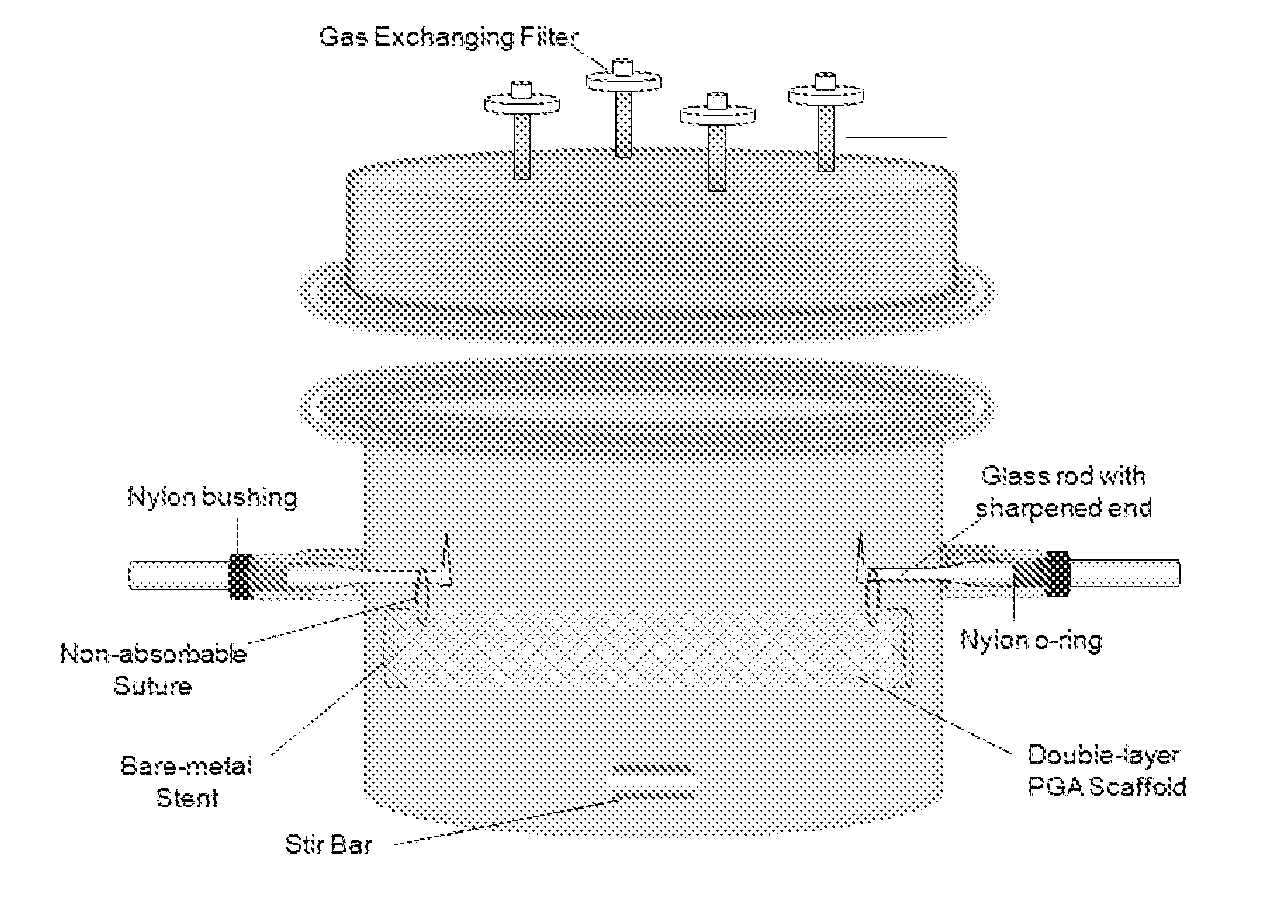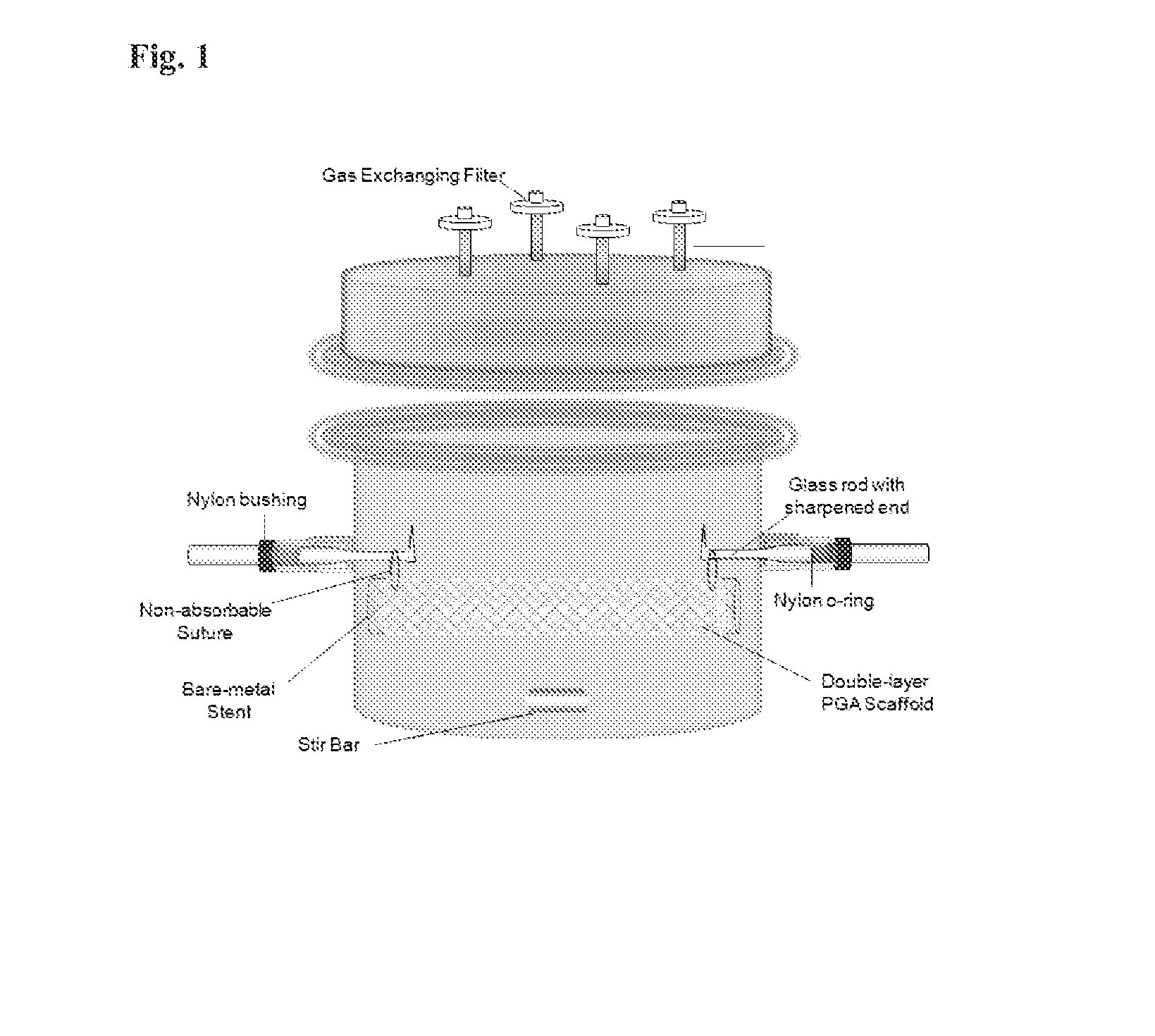Tubular prostheses
a technology of tubular prosthesis and prosthesis, which is applied in the field of artificial replacements, can solve the problems of many complications, no replacements currently available, and no available replacement of esophageal tissu
- Summary
- Abstract
- Description
- Claims
- Application Information
AI Technical Summary
Benefits of technology
Problems solved by technology
Method used
Image
Examples
example , 1
Example, 1
Tracheal PGA Scaffold Preparation
[0055]A poly(glycolic) acid (PGA) sheet is cut into 5.4 cm×8.5 cm and 5.2 cm×8.5 cm pieces. 5.2 cm×8.5 cm PGA mesh is rolled into a tube and inserted inside a bare-metal stent (1.7×8.5 cm). 5.4 cm×8.5 cm PGA mesh is then sewn around the bare-metal stent using the absorbable PGA suture, sandwiching the stent between the two layers of PGA mesh. A crochet needle is applied carefully throughout the PGA / stent construct to interlace the two PGA layers together. A non-absorbable suture is sewn through both ends of PGA / stent construct to suspend the construct inside a specially designed bioreactor for trachea reconstruction. The construct is then dipped into 1M NaOH solution for 2 minutes to treat the surface of the PGA mesh followed by three rinsing in distilled water. The PGA / stent construct is then assembled in the bioreactor as shown in
example 2
Smooth Muscle Cells (SMC) Seeding and Tracheal Culture Maintenance
[0056]Primary SMCs were isolated from dog aortas and expanded in T-75s in 20% fetal bovine serum (FBS) low glucose Dulbecco's Modified Eagle's Medium. 120 million SMCs of P2 and P3 were re-suspended in 7 ml of medium and seeded onto the PGA / Stent construct inside the bioreactor, as shown in FIG. 2. The construct was cultured inside the bioreactor statically for 12 weeks in 1.3 L of low glucose Dulbecco's Modified Eagle's Medium with 20% FBS, basic fibroblast growth factor (10 ng / ml), platelet derived growth factor (10 ng ml), L-ascorbic acid, copper sulfate, HEPES, L-proline, L-alanine, L-glycine, and Penicillin G (FIG. 2), Medium was changed 1.5 times per week and ascorbic acid was supplemented three times per week.
example 3
Decellularization of Engineered Trachea
[0057]Engineered trachea (6 cm in length) was first incubated in 250 mL CHAPS buffer (8 mM CHAPS, 1M NaCl, and 25 mM EDTA in PBS) for 45 minutes at 37 C.° under high-speed agitation, followed by thorough sterile PBS rinsing. The engineered trachea was further treated with 250 mL sodium dodecyl sulfate (SDS) buffer (1.8 mM SDS, 1M NaCl, and 25 mM EDTA in PBS) for 45 minutes at 37 C.° with high-speed agitation. The engineered trachea then underwent 2 days of washing in PBS to completely remove the residual detergent. All decellularization steps were performed under sterile conditions. The decellularized engineered trachea was stored in sterile PBS containing penicillin 100 U / mL and streptomycin 100 mg / mL at 4 C.°.
PUM
 Login to View More
Login to View More Abstract
Description
Claims
Application Information
 Login to View More
Login to View More - R&D
- Intellectual Property
- Life Sciences
- Materials
- Tech Scout
- Unparalleled Data Quality
- Higher Quality Content
- 60% Fewer Hallucinations
Browse by: Latest US Patents, China's latest patents, Technical Efficacy Thesaurus, Application Domain, Technology Topic, Popular Technical Reports.
© 2025 PatSnap. All rights reserved.Legal|Privacy policy|Modern Slavery Act Transparency Statement|Sitemap|About US| Contact US: help@patsnap.com



